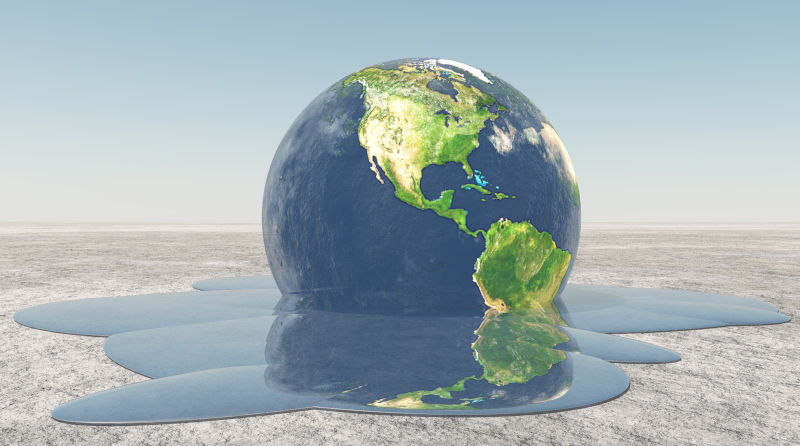Environment: Life scientists endorse civil disobedience
February 4, 2023
Australias oceans, Greenlands Ice Sheet and Antarcticas sea ice are all feeling the heat. One million species are on the edge of extinction. No wonder life scientists are taking to the streets.
Australia is in hot water
Although the global warming that has occurred over the oceans is lower than the warming over land, about 90% of the heat that has been added to the Earth by the greenhouse effect has been absorbed by the worlds oceans. Last year the oceans absorbed about 100 times as much solar energy as the worlds electricity systems produce each year and the ocean heat content reached a record high for the fourth year in a row. It’s not just the surface water that is warming, the depths are also heating up.
As with warming over land, there are geographic variations in the warming over water and Australia is sitting in one of the areas with the greatest ocean warming, especially around the north and north-east coast and south of Tasmania.
Warmer water doesnt just mean more comfortable swimming for all us wimps. It also sets the scene for ocean heatwaves such as the ones that devastated vast areas of the Great Barrier Reef a few years ago. The combination of warmer water and warmer overlying air also leads to the air taking up more moisture and this creates the conditions for more severe monsoons and cyclones such as those experienced in the last year in Pakistan, the USA and, of course, here. Hand in hand with this, some places have experienced longer and more intense droughts. Unfortunately both floods and droughts lead to crop failures.
Antarctic sea ice is decreasing
Extent of Antarctic sea ice on 28 December 2022
The extent of Antarctic sea ice in the southern summer has been decreasing since 2016 and has this season dropped to its lowest extent on record. Global warming is probably a contributor as the Southern Ocean encircling Antarctica has been storing a disproportionate amount of the heat in the worlds oceans in recent years. However, changed wind patterns, which themselves may be a reflection of global warming, seem to be the major cause at the moment by pushing sea ice further north into warmer water and air. While melted sea ice doesnt raise sea levels, the loss of sea ice has many physical and biological consequences. Less sea ice speeds up the flow of the Antarctics glaciers into the ocean and decreases the reflectivity of the ocean, increasing the amount of solar energy absorbed and further increasing global warming. Loss of sea ice also affects the timing of plankton blooms which disrupts the feeding patterns of birds, fish and sea mammals.
And at the other end (if an oblate spheroid has ends)
The Greenland Ice Sheet is melting
The Greenland Ice Sheet is about the size of Queensland and over three kilometres thick in places. It plays a crucial role in the global climate system. Global warming is known to be occurring more quickly in the Arctic (and other cold places) than the global average and new research has shown that the temperature over the Greenland Ice Sheet was 1.5oC higher in the first decade of the 21st century than the 20th century average. It was also higher than at any time in the last 1000 years. This is a result of the combined effect of natural variation and a long term warming trend since about 1800. Warmer doesnt just mean a higher temperature, it also increases the length of the melt season and pushes the melt boundary further north.
No matter how much success we might have controlling greenhouse gases, the global warming that has already occurred will, over this century, melt the Greenland Ice Sheet sufficient to raise the sea level by about 25cm. At the current rate of melting, the sea level will rise 50cm.
In addition to raising the sea level, the melting ice also creates rivers and lakes on top of the ice sheet, which are visually stunning even if they are a sign of bad things to come.
One million species on the brink
We are currently experiencing - or rather causing through hunting (for sport and food), pollution, habitat loss, competition from introduced species, climate change - the sixth mass extinction of animal and plant species in the last 500 million years. During previous mass extinctions, more than 75% of species became extinct over about two million years. Incredibly 96% disappeared in the event 250 million years ago (aptly named the Great Dying). The current rate of extinctions is 100-1,000 times higher than the normal background rate at which species disappear through the regular processes of evolution.
About 900 animal species are classed as having gone extinct since 1500 and, as the graphic below clearly demonstrates, the rate has increased dramatically in the last 200 years (each dot represents an animal species we wont see again). In addition there are about 600 animal species that are suspected to have become extinct. Currently, amphibians are the most threatened species, followed by mammals, reptiles and then birds. However, even among many species that are considered least at risk, population numbers have declined greatly in recent decades, with birds having suffered the greatest losses.
It’s worth noting in passing that we have identified only about one-seventh of the estimated 8.7 million species of animals, plants, fungi, microorganisms, etc. on Earth. Many of the other six-sevenths are no doubt disappearing without our knowledge.
Conservation efforts have had some success in preventing the extinction of a few bird and mammal species in recent decades but these are scattered oases in the Desert of the Departed.
Scientists are citizens before scientists
The UK branch of Extinction Rebellion has decided to put a (currently temporary) halt on demonstrations that obstruct the publics normal activities, arguing that evidence indicates that being inconvenienced alienates people who are in general supporters of climate action.
The people producing the evidence behind this weeks previous four articles are, however, moving in the opposite direction. Members of Scientist Rebellion are calling on scientific colleagues, mentors, students and teachers to engage in advocacy and activism, including nonviolent civil resistance, to highlight the increasingly devastating impact of the current economic and political structures on the Earths climate and ecosystems (with particular emphasis on loss of biodiversity, threats to food security and human health, and deteriorating mental health, e.g. eco-anxiety).
Life scientists, they argue, have done a great job investigating and documenting the causes and impacts of the environmental crises but have failed to drive governments to make the transformative societal changes necessary to avert the worst consequences. Scientists and their universities have also failed to teach students about and engage the public with environmental problems and their consequences. On the contrary, in fact, universities have been adopting corporate structures and goals which have emphasised the responsibility of individuals and discouraged collective action.
Gone are the days when it was sufficient for academics to rely on evidence and polite appeals to dominant structures of power, particularly when those very same structures are the ones we are trying to transform. Citing historical examples of scientists as activists (Nightingale, Garrett Anderson, Russell, Einstein, Hansen and more), the authors call for scientists to find better ways to connect with the public, openly participate in popular movements, incorporate advocacy and activism in teaching, conduct relevant research, and change the ways universities think and operate. Apart from civil disobedience, perhaps Scientist Rebellions most controversial recommendation is to name the forces behind the climate and ecological crises: extractivist capitalism, settler-state colonialism, corporate capture of state institutions and citizen disenfranchisement.
The authors conclude: Let us not turn ourselves into passive witnesses of mass death and extinction. We are life scientists after all lets stand up for life.
Its no secret that Im a supporter of and occasional participant in nonviolent civil disobedience. I also strongly support naming the enemy, and not just the forces or even the responsible corporations behind the crises. The enemies are flesh-and-blood individuals. Shell, Glencore, AGL, Westpac, Monsanto, Union Carbide and all the others dont make decisions. The decisions are made, endorsed and implemented by individual board members, investors and senior executives of such companies. These real but often hidden people are responsible for the environmental and social problems created by their companys operations and products. Not forgetting the politicians who, through corruption, incompetence, self-interest or whatever, create the rules that allow this to happen. These people are the real enemies, not the clearly visible but also anonymous corporate and government entities that they hide within.
Plastics greenhouse gas emissions
Plastics currently generate almost one billion tons of greenhouse gases per year. This is projected to roughly treble by 2050 as oil companies expand plastic production to make up for the revenue they will lose as burning oil for fuel loses favour.






